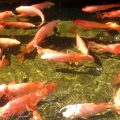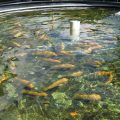Tilapia farmers claim that the biggest slice in their production cost is spent for commercial supplemental feed. This is because intensified tilapia production has resulted in growers’ dependency on commercial feed.

Findings of researchers of the Freshwater Aquaculture Center of the Central Luzon State University (FAC-CLSU) have shown that the cost of supplemental feed accounts for about 60 percent of the total production cost. This means that for every P 10 spent in the production of tilapia, P6 is spent for feeds. That’s big. Tilapia growers would surely derive more income from their enterprise if the amount spent for feeds is reduced considerably.
It is for this reason that scientists of the North Carolina State University (NCSU) in Raleigh, North Carolina have been continuously collaborating with researchers in the Philippines, Cambodia, China, Kenya and Mexico on the conduct of studies on tilapia feeding strategies.
Generally known as a Collaborative Research Support Program (CRSP), the project has already assumed three names as follows: Pond Dynamics/Aquaculture CRSP (1982-1999), Aquaculture CRSP (2000-2005), and Aquaculture and Fisheries CRSP or AquaFish CRSP (2006-2011). It is one of the 11 CRSPs that were created to link the capabilities of US agricultural universities with the needs of developing countries.
In the Philippines, the project is being led by Dr. Remedios B. Bolivar of the FAC-CLSU as host country principal investigator since 1982. Dr. Russell J. Borski of NCSU, on the other hand, is the CRSP US lead principal investigator. The project is funded by the US Agency for International Development (USAID), NCSU, and CLSU.
So far, two effective feeding strategies have been found. These are delayed feeding, and alternate day feeding. A third strategy, called sub-satiation feeding, has no effect on growth and yield.
DELAYED FEEDING
Dr. Bolivar said the idea of delayed feeding is not new as Thai researchers led by Dr. J. Diana found in 1966 that delayed feeding could save some cost of production without affecting fish yield. A considerable savings could be achieved if this feeding strategy ig applied on a large scale.
The CRSP study at FAC-CLSU was conducted in seven farms. Each participating farm allowed the use of two ponds, which were stocked with sex-reversed GIFT (genetically improved fast growing tilapia) strain of Nile tilapia at an initial density of four fish per square meter.
Each pond was fertilized weekly with inorganic fertilizer at the rates of 28 kg nitrogen (N)/ha and 5.6 kg phosphorus (P)/ha. These rates are equivalent to 5 1 kg urea (46-0-0) and 28 kg ammonium phosphate (16-20-0) per hectare. Fertilization was needed for the production of algae (lablab), which the fish consumed before the start of supplemental feeding.
In their experiment, FAC-CLSU researchers started giving supplemental feed to the fish at 45 and 75 days after stocking. Supplemental feeding continued until harvest at 150 days after stocking.
The results showed that while fish given supplemental feed starting at 45 days after stocking weighed heavier at harvest (average of 164 grams), they also consumed more feed amounting to 8,299 kg/ha. This amount of feed was 2,231 kg/ha more than the consumption of fish given supplemental feed starting at 75 days after stocking.
Based on data provided by Dr. Bolivar, the total value of feed consumption starting at 45 days after stocking until harvest (P235,110/ha) was 81 percent of the total production cost of P334,100/ha. On the other hand, the total value of feed consumed starting at 75 days after stocking until harvest (P171,906/ha) was almost 78 percent of the total production cost of P320,190/ha.
Computed per hectare, delayed feeding starting at 75 days after stocking resulted in a higher net return of P99,133. In contrast, a.net return of only P44,332/ha was obtained from delayed feeding starting at 45 days after stocking.
ALTERNATE DAY FEEDING
In the alternate feeding strategy, supplemental feed is given to the fish every other day. In other words, feed is not given the day after the provision of supplemental feed.
In their study, Dr. Bolivar and her team compared daily feeding with alternate day feeding to determine if the cost of producing tilapia could be significantly reduced without significantly reducing fish production. Supplemental feeding started at 45 days after stocking.
As in the study on delayed feeding, this trial also showed that while fish in the daily feeding strategy had a heavier weight at harvest (average of 167 grams), they also consumed more feeds (6,331 kg/ha) than those in the alternate feeding strategy (2,807 kg/ha).
As a result, the total value of feed consumption in the daily feeding strategy (P163,339/ha) was a lot higher than that consumed in the alternate feeding strategy (P69,376/ha). These data mean that the value of feed consumed in the daily feeding strategy was almost 73 percent of the total production cost, while that in the alternate feeding system was only 58 percent.
In the final analysis, the daily feeding strategy even resulted in a negative net income of minus P30,166/ha. In great contrast, a net return of P62,435/ha was realized from the alternate day feeding strategy.
In another study, the FAC-CLSU researchers tried to find out if sub-satiation feeding could also effectively reduce production cost without adversely affecting fish production. Seven farms also participated in this study and allowed the use of two ponds each. As in the two other studies, each pond was also fertilized with inorganic fertilizers at the rates of 28 kg N/ha/week and 5.6 kg P/ha/week.
Two amounts of supplemental feeds were given to the fish starting at 45 days after stocking. In one pond, tilapia was fully fed daily at 100 percent, but only 67 percent was given in the other pond.
Results did not show any benefit from sub-satiation up to 67 percent. Perhaps, some benefits could be derived from a more moderate feeding but this still remains to be proven.
Overall, Dr. Bolivar said these feeding strategies are environmentally desirable because the amount of organic materials loaded into fishponds is significantly reduced. These strategies could also be easily adopted by fishpond operators since the techniques do not require any complicated procedure or input. Moreover, a considerable amount of money is saved through delayed feeding and alternate day feeding.
So try them and you’ll be amazed at the results.
Source: http://www.agribusinessweek.com/tilapia-feeding-strategies-for-more-income/





